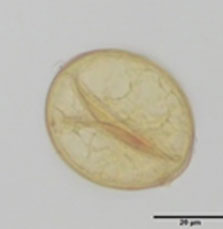ประชากรราอาร์บัสคูลาร์ไมคอร์ไรซาในพื้นที่ปลูกสับปะรด จังหวัดประจวบคีรีขันธ์ และจังหวัดเพชรบุรี
คำสำคัญ:
ราอาร์บัสคูลาร์ไมคอร์ไรซา, การจัดจำแนก, สับปะรดบทคัดย่อ
การวิจัยนี้มุ่งเน้นศึกษาความหลากหลายของราอาร์บัสคูลาร์ไมคอร์ไรซา ในพื้นที่ปลูกสับปะรด จ.ประจวบคีรีขันธ์ และ จ.เพชรบุรี เพื่อเป็นแนวทางในการเพิ่มความเป็นประโยชน์ของธาตุอาหารพืชและลดการใช้ปุ๋ยเคมี โดยเก็บตัวอย่างดินในพื้นที่ปลูกสับปะรด จำนวน 5 แปลง นำมาวิเคราะห์ทางเคมีและจำแนกชนิดรา พบว่าเนื้อดินแตกต่างกัน เป็นดินเหนียว ดินร่วนทราย ดินร่วนเหนียวปนทราย และดินทรายปนร่วน นับจำนวนสปอร์ พบว่าในแปลงที่ 3 มีจำนวนประชากรของราสูงที่สุด (2.48 สปอร์ต่อดินแห้ง 1 กรัม) ในแปลงที่ 4 และ 5 พบสปอร์จำนวนน้อยที่สุด (0.11 และ 0.13 สปอร์ต่อดินแห้ง 1 กรัม) ในการจำแนกชนิดราสามารถจำแนก ได้ 5 ชนิด แปลงที่ 1 มีความหลากหลายมากกว่าแปลงอื่น พบราทั้งหมด 3 ชนิด ๆ ที่พบมากที่สุด ได้แก่ รา Paraglomus brasillianum รองลงมา คือ Septoglomus constrictum และ Acaulospora spinosa ในขณะที่แปลงที่เหลือพบคล้ายกัน ได้แก่ Acaulospora mellea และ Paraglomus occultum สรุปได้ว่าจำนวนประชากรจะขึ้นอยู่กับปริมาณอินทรียวัตถุ ส่วนความหลากหลายขึ้นอยู่กับเนื้อดินและปริมาณธาตุอาหาร
เอกสารอ้างอิง
พักตร์เพ็ญ ภูมิพันธ์. 2556. บทบาทของราอาร์บัสคูลาร์ไมคอร์ไรซาต่อพืช ดิน และสิ่งแวดล้อม. วารสารวิทยาศาสตร์และเทคโนโลยี 2(2): 91-101, doi: 10.14456/tjst.2013.16.
นภาพร คงตุก และ จรัสลักษณ์ เพชรวัง. 2560. การคัดแยกเชื้อราอาร์บัสคูลาร์ไมคอร์ไรซาจากสวนพริกไทยในจังหวัดนครศรีธรรมราชและสุราษฎร์ธานี. แก่นเกษตร 45 ฉบับพิเศษ 1: 481-486.
นาฏยา แพทย์พิทักษ์, ธัญพิสิษฐ์ พวงจิก และ พักตร์เพ็ญ ภูมิพันธ์. 2556. การสำรวจประชากรเชื้อราอาร์บัสคูลาร์ไมคอร์ไรซาบริเวณเขตรากไผ่ในพื้นที่เกษตรกรรม และพื้นที่ป่าธรรมชาติ, น. 2302-2310. ใน การประชุมวิชาการแห่งชาติ มหาวิทยาลัยเกษตรศาสตร์ วิทยาเขตกําแพงแสน ครั้งที่ 9. มหาวิทยาลัยเกษตรศาสตร์.
สุภาพร ธรรมสุระกุล, สมเพชร เจริญสุข และ ออมทรัพย์ นพอมรบดี. 2549. การเพิ่มประสิทธิภาพการใช้ปุ๋ยเคมีกับสับปะรดโดยใช้ราไมโคไรซ่าสายพันธุ์ต่าง ๆ, หน้า 18-35. ใน ผลงานฉบับเต็มขอประเมินเพื่อแต่งตั้งให้ดำรงตำแหน่งนักวิชาการเกษตร 7ว. สำนักวิจัยพัฒนาปัจจัยการผลิตทางการเกษตร, กรุงเทพฯ:
เอิบ เขียวรื่นรมณ์. 2547. คู่มือปฏิบัติการการสำรวจดิน. พิมพ์ครั้งที่ 5 ภาควิชาปฐพีวิทยา คณะเกษตร. มหาวิทยาลัยเกษตรศาสตร์, กรุงเทพฯ. 182 หน้า.
Anderson, R.C., A.E. Liberta and L.A. Dickman. 1984. Interaction of vascular plants and vesicular-arbuscular mycorrhizal fungi across a soil moisture-nutrient gradient. Oecologia 64(1): 111-117.
Bray, R.H. and L.T. Kurtz. 1945. Determination of total, organic, and available forms of phosphorus in soils. Soil Science 59: 39-45.
Carrenho, R., S.F.B. Trufem, V.L.R. Bononi and E.S. Silva. 2007. The effect of different soil properties on arbuscular mycorrhizal colonization of peanuts, sorghum and maize. Acta Botanica Brasilica 21(3): 723-730, doi: 10.1590/S0102-33062007000300018.
Danesh, Y.R., S. Najafi and S. Demir. 2016. Using in vitro culturing technique for studying life cycle of
arbuscular mycorrhizal fungus (AMF) Glomus intraradices. Yuzuncu Yil University Journal of Agricultural Sciences 26(2): 161-167.
Gee, G.W. and J.W. Bauder. 1986. Particle-size analysis, pp. 961-1010. In A. Klute, (ed.) Methods of Soil Analysis, Part I. Physical and Mineralogical Methods. American Society of Agronomy, Inc., Madison, Wisconsin, USA.
Gravito, M.E., and M.H. Miller. 1998. Changes in mycorrhizal development in maize induced by crop management practices. Plant and Soil 198: 185-192.
Johnson, N.C., D.R. Zak, D. Tilman and F.L. Pfleger. 1991. Dynamics of vesicular-arbuscular mycorrhizae during old field succession. Oecologia 86: 349-358.
Johnson, N.C., D. Tilman and D. Wedin. 1992. Plant and soil controls on mycorrhizal fungal communities. Ecology 73: 2034-2042, doi: 10.2307/1941453.
Kim, S.J., J.K. Eo, E.H. Lee, H. Park and A.H. Eom. 2017. Effects of arbuscular mycorrhizal fungi and soil conditions on crop plant growth. Mycobiology 45(1): 20-24, doi: 10.5941/MYCO.2017.45.1.20.
Lee, E.H., J.K. Eo , K.H. Ka and A.H. Eom. 2013. Diversity of arbuscular mycorrhizal fungi and their roles in ecosystems. Mycobiology 41(3): 121-125, doi: 10.5941/MYCO.2013.41.3.121.
Liu, W., Y. Zhang, S. Jiang, Y. Deng, P. Christie, P.J. Murray, X. Li and J. Zhang. 2016. Arbuscular mycorrhizal fungi in soil and roots respond differently to phosphorus inputs in an intensively managed calcareous agricultural soil. Scientific Reports 6:24902, doi: 10.1038/srep24902.
Lekberg, Y., R.T. Koide, J.R. Rohr, L. Aldrich-Wolfe and J.B. Morton. 2007. Role of niche restrictions and dispersal in the composition of arbuscular mycorrhizal fungal communities. Journal of Ecology 95: 95–105, doi: 10.1111/j.1365-2745.2006.01193.x.
Marx, D.H. 1973. Mycorrhizae and feeder root diseases, pp. 351-382. In G.C. Marks, T.T. Kozlowski (eds.). Ectomycorrhizae: Their Ecology and Physiology. Academic Press, Inc., New York.
Naher, U.A., R. Othman and Q.A. Panhwar. 2013. Beneficial effects of mycorrhizal association for crop production in the tropics - a review. International Journal of Agriculture and Biology 15(5): 1021-1028.
National Soil Survey Center. 1996. Soil Survey Laboratory Methods Manual. United States Department of Agriculture, Natl. Soil Surv. Cent., Soil Surv. Lab., Soil Survey Investigation No. 42, Version 3.
Nelson, D.W. and L.E. Sommers. 1996. Total carbon, and organic matter, pp. 961-1010. In D.L. Sparks, A.L. Page, P.A. Helmke and R.H. Loeppert, (eds.). Methods of Soil Analysis. Part III. Chemical Method. Amer. Soc. Agron. Inc., Madison, Wisconsin, USA.
Pearson W.R. 2013. An introduction to sequence similarity (“Homology”) searching. Current protocols bioinformatics. Chapter 3:3.1.1-3.1.8., doi: 10.1002/047125 0953.bi0301s42.
Redecker D., A. Schüßler, H. Stockinger, S.L. Stürmer, J.B. Morton and C. Walker. 2013. An evidence-based consensus for the classification of arbuscular mycorrhizal fungi (Glomeromycota). Mycorrhiza 23: 515-531, doi: 10.1007/s00572-013-0486-y.
Rodríguez-Romero, A.S., R. Azcón and M.D.C. Jaizme-Vega. 2011. Early mycorrhization of two tropical crops, papaya (Carica papaya L.) and pineapple [Ananas comosus (L.) Merr.], reduces the necessity of P fertilization during the nursery stage. Fruits 66(1): 3-10, doi: 10.1051/fruits/2010036.
Schenck, N.C. 1981. Can mycorrhizae control root diseases. Plant Disease 65: 230-234.
Silvana, V.M., F.J. Carlos, A.C. Lućia, A. Natalia and C. Marta. 2020. Colonization dynamics of arbuscular mycorrhizal fungi (AMF) in Ilex paraguariensis crops: Seasonality and influence of management practices. Journal of King Saud University – Science, doi: 10.1016/j.jksus.2018.03.017.
Thomas, G.W. 1982. Exchangeable cations, pp. 159-165. In C.A. Black, (ed.) Methods of Soil Analysis, Part 2. Chemical and Microbiological Properties. 2nd. Agronomy No. 9. ASA and SSSA. Inc., Madison, Wisconsin, USA.
Trappe, J.M. and N.C. Schenck. 1982. Taxonomy of the fungi forming endomycorrhizae, pp. 1-9. In N.C. Schenck, (ed.). Methods and Principles of Mycorrhizal Research. The American Phytopathological Society St. Paul, Minnesota, USA.
Wang, G.M., D.P. Stribley, P.B. Tinker and C. Walker. 1993. Effects of pH on arbuscular mycorrhiza, I. Field observations on the long-term liming experiments at Rothamsted and Woburn. New Phytologist 124: 465-472, doi: 10.1111/j.1469-8137.1993.tb03837.






